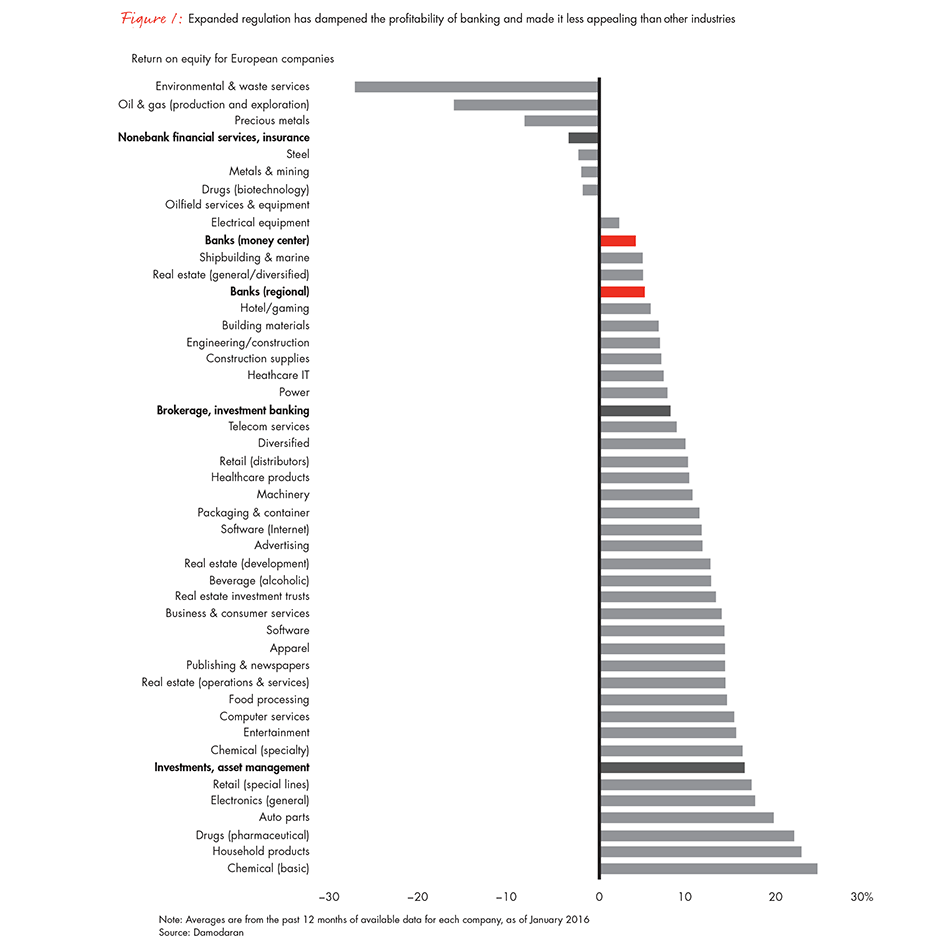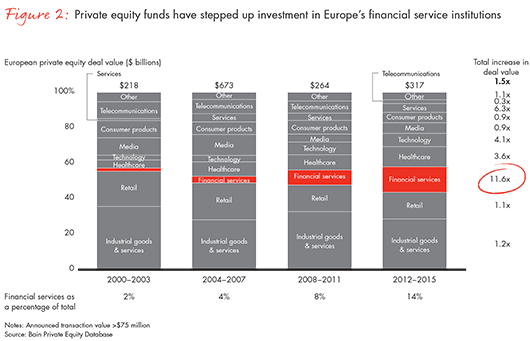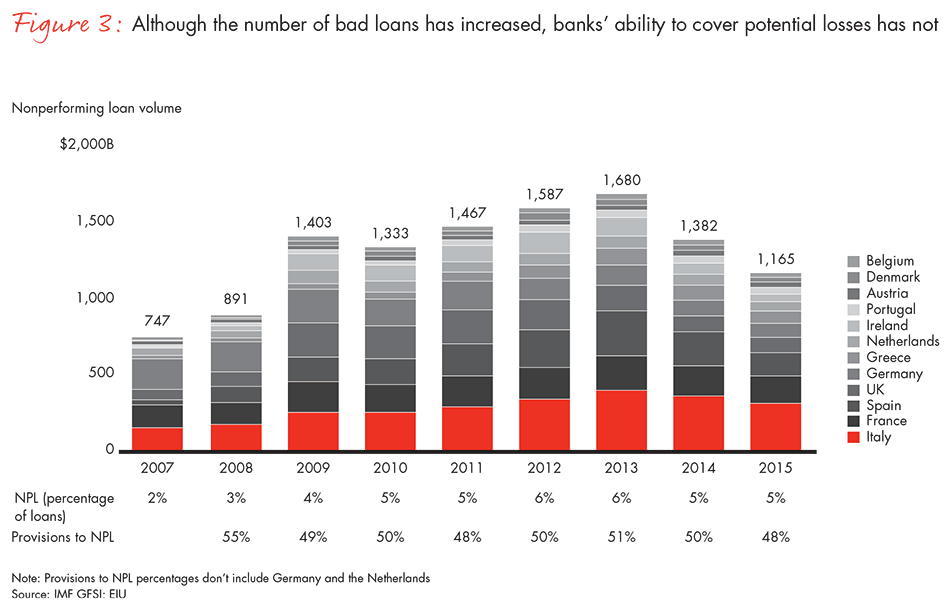Brief

Europe’s large banks just can’t seem to get enough capital. Bailouts in 28 countries since September 2008 have totaled approximately €1.5 trillion, a huge sum of taxpayer money that has put pressure on banks to improve their balance sheets and their performance. And the well is running dry.
Complicating matters, Europe’s states want their money back, and bailed-out banks have come under pressure to exit their state ownership. A few recent examples: The Irish state injected €21 billion in Allied Irish Banks between 2009 and 2011 and now, after the management team successfully transformed the bank, the state wants to sell around €4.5 billion of its stake. Portugal pushed Banif to find a buyer for the state’s 61% share, which sold to Santander. The UK’s bailout of Lloyds shows a better picture: Share sales have generated a £1.2 billion profit for taxpayers on the £15 billion of shares sold to date, the Financial Times reported.
Who will buy the business units or loan portfolios from struggling banks? Many other banks, whether within or outside Europe, have their own capital issues to deal with and have not eagerly sought to acquire new assets. Although European banks’ return on equity (ROE) recovered to more than 5% in 2015 after bottoming out in 2011, according to SNL, no one expects ROE to match the 15% that banks enjoyed in 2007 (see Figure 1).
But there is an attractive alternative group of buyers with ample capital and expertise: private equity firms. Private equity currently has plenty of dry powder—capital waiting to be put to work—as well as plenty of experience turning around ailing banks’ strategy and operations. We consider PE funds a worthy, temporary shareholder into which governments and banks can offload assets to raise capital. After the typical holding period of about five years, PE investors will be keen to realize their returns. During that time, European banks could build enough muscle into their balance sheets to absorb the revitalized assets. If not, the revitalized banks would be in a stronger position to continue standalone operations through an initial public offering (IPO).

Why private equity makes sense
The private equity solution has a firm foundation, as several PE funds have consistently invested in banking over the past five years (see Figure 2). For example, AnaCap Financial Partners has invested in small and midsize enterprises (SME) banking through Aldermore Bank in the UK and FM Bank in Poland. Advent International and Bain Capital have deepened their expertise in payments and cards through investments in ICBPI, Nets and Worldpay. During their Worldpay ownership, the Wall Street Journal reported that Advenand Bain Capital helped Worldpay achieve an impressive 11% compound annual growth rate in underlying EBITDA and built its value by £3.2 billion over a five-year period.
Besides their ample experience to date, PE firms have other characteristics that make them logical buyers.
Substantial dry powder. Private equity reported a 9% increase in dry powder in the past year, reaching $755 billion as of June 2015. The total dry powder of private capital, which includes debt, real estate and infrastructure, reached $1.3 trillion. The past year saw the best environment for fund-raising since the pre-crash boom. Financial services’ share of total deal value in Europe grew from 2% to 14% over the past 15 years (see Figure 2).

Transitional ownership. Funds held their buyout investments for an average 5.5 years as of 2015. Their ability to deliver results to investors depends on quickly turning around businesses, improving operational efficiency and putting companies back on a growth path to ready them for sale or IPO.
General partners have the flexibility to act quickly if the situation calls for speed. When a government or a bank needs capital fast, private equity firms can mobilize faster and with more confidence than most other sources of capital. They do not come under the public scrutiny that governments deal with, and they can quickly narrow the decision criteria to the few critical decisions that will generate the most value.
Continued competition. Selling one bank to another implies one fewer competitor in the market. As consolidation proceeds, a lack of competition can hurt underserved groups of customers. Lending volumes to SMEs, for example, fell by almost half during the financial crisis. The elevated borrowing costs created a demand/supply gap that persists, even after the creation of a number of smaller banks and peer-to-peer lending firms. Private equity buyers will select a strategy that is designed to realize the full potential of their acquired bank. Although that strategy might involve a sale to a larger bank, in many cases the smaller bank can thrive on its own. Alternatively, a PE fund will orchestrate a merger between two subscale players, such as the merger of PBP Bank and FM Bank in Poland. In either case, market competition is preserved through a new, revitalized bank.
Next moves for private equity funds
Full banks. Few PE funds currently choose to take on full bank balance sheet risk, though cases do exist: AnaCap Financial Partners with Banco Popolare Ceska, Aldermore, Mediterranean Bank and FM Bank; and Lone Star with IKB Deutsche Industriebank. As more funds try their hand at full banking transactions, they might become more confident in pursuing other such investments. Most PE funds, however, prefer to buy business units or loan portfolios. Governments or banks that are looking to divest thus should consider the option of splitting assets before a sale, through a couple of methods.
Carve-outs of divisions. Splitting a bank into multiple businesses stands to attract more interest from focused buyers. Banco Espírito Santo, for example, first went through a good bank/bad bank separation. The good bank Novo Banco then sold its insurance and its investment arms; now the government is trying, for the second time, to sell the remaining assets. In the recent case of four banche popolari, or mutual banks, on sale in Italy, the chairman appointed to conduct the sale expressed preference for a single deal, but said multiple deals were possible.
The viability of this option will depend on stakeholders’ preferences. On the sell side, bankers must be willing to execute the carve-out and map a timeline for the transaction. On the buy side, a PE fund must be able to coordinate with other interested parties and agree to take on noncore assets.
Portfolio cleanup. Banks have been offloading bad debt portfolios in the past few years, with UK, Irish, Spanish and Italian banks among the big sellers of bad debt, according to Dealogic data. For example, UniCredit sold its bad loan unit UCCMB—with a gross book value of €2.4 billion—to a consortium led by US asset management group Fortress for about €500 million. And Banca Monte dei Paschi di Siena disclosed that it sold a loan portfolio worth €1.3 billion to Cerberus Capital Management and Banca IFIS. Nonperforming loans (NPLs) now represent 5% of total loans and a $1.2 trillion pool of assets in 12 European economies, up from 2% in 2007 (see Figure 3).

Yet although the volume of NPLs has doubled, provisions to absorb potential losses have not increased. With various regulators attempting to reduce the pool of NPLs, we expect banks to pursue more loan portfolio sales to specialized recovery firms or experienced private equity funds.
As governments and regulators put more pressure on banks to resolve capital shortfalls and exit state ownership, private equity offers a logical and attractive path to recovery. Deep pockets combined with the capability to turn around assets are in high demand. Private equity firms thus could serve as a bridge between today’s capital-constrained banking market and tomorrow’s more solid financial system. An expanded role for private equity in European banking could not be better timed, with potential gains for all parties: banks, PE funds, governments and the customers that depend on banks in their financial lives.
João Soares is a partner with Bain’s Financial Services practice and leads the firm’s banking transformation work in Europe, the Middle East and Africa. Tim Cochrane is a partner in the firm’s Financial Services and Private Equity practices; for the latter, he leads the financial services sector in Europe, the Middle East and Africa. Vitor D’Agnoluzzo is a manager with the Financial Services practice. They are all based in London.

